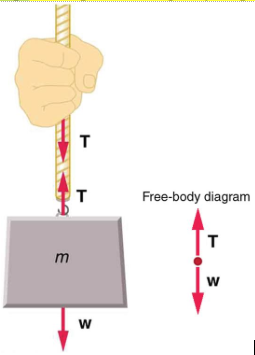| << Chapter < Page | Chapter >> Page > |
[BL] Review the concept of weight as a force.
[OL] Ask students what happens when an object is dropped from a height. Why does it stop when it hits the ground? Introduce the term normal force.
Forces are classified and given names based on their source, how they are transmitted, or their effects. In previous sections, we discussed the forces called “push,” “weight,” and “friction.” In this section, applying Newton’s third law of motion will allows us to explore three more forces: the normal force , tension , and thrust . However, because we haven’t yet covered vectors in depth, we’ll only consider one-dimensional situations in this chapter. The next chapter will consider forces acting in two dimensions.
The gravitational force (or weight) acts on objects at all times and everywhere on Earth. We know from Newton’s second law that a net force produces an acceleration; so why is everything not in a constant state of freefall toward the center of Earth? The answer is the normal force. The normal force is the force that a surface applies to an object to support the weight of that object; it acts perpendicular to the surface upon which the object rests. If an object on a flat surface is not accelerating, the net external force is zero, and the normal force has the same magnitude as the weight of the system but acts in the opposite direction. In equation form, we write that
Consider a person holding a mass on a rope as shown in [link] .

When a perfectly flexible connector (one requiring no force to bend it) such as an ideal rope transmits a force T, this force must be parallel to the length of the rope, as shown. The pull that such a flexible connector exerts is a tension. Note that the rope pulls with equal magnitude force but in opposite directions on the hand and on the mass (neglecting the weight of the rope). This is an example of Newton’s third law. The rope is the medium that transmits between the two objects forces of equal magnitude but that act in opposite directions.

Notification Switch
Would you like to follow the 'Updated tutor hs physics content - legacy' conversation and receive update notifications?